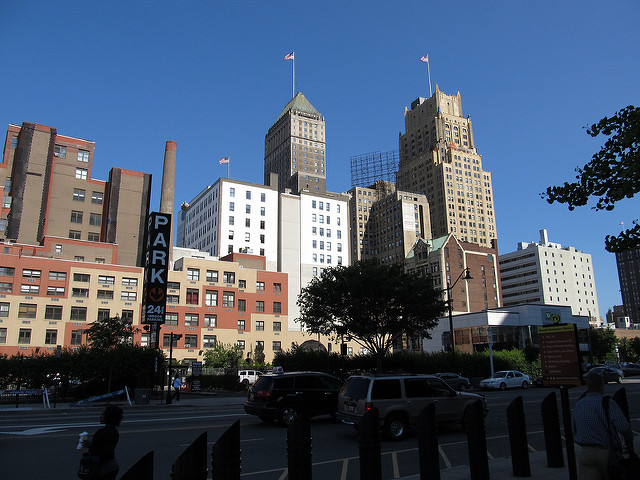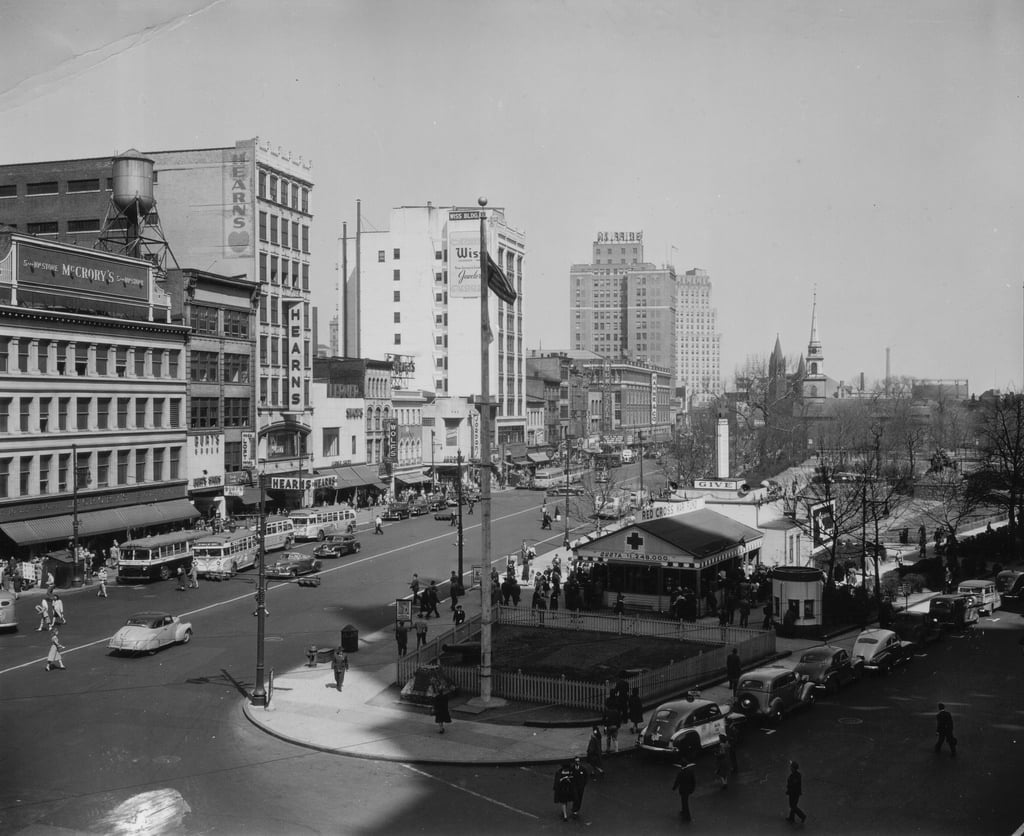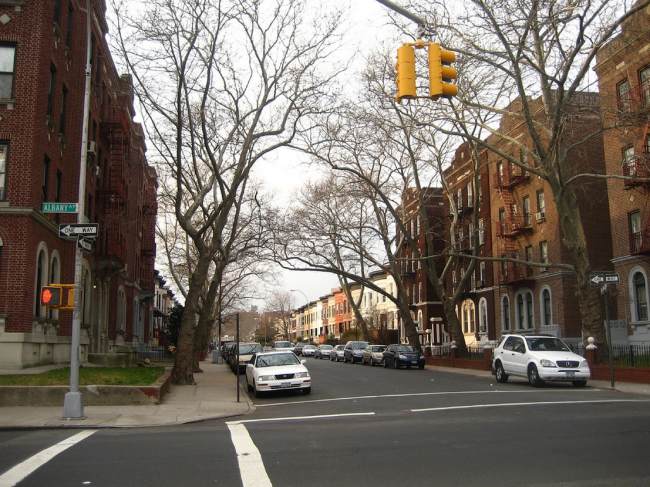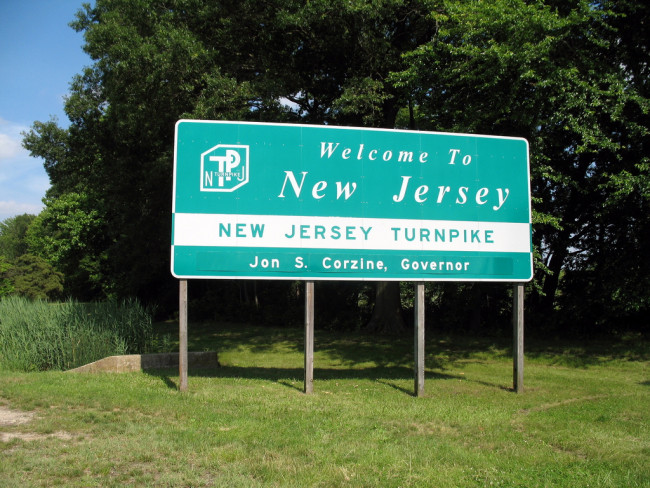Explore Newark's unsung historic districts

Hotel Indigo (left) and the First Presbyterian Church, built in 1666, in one of Newark's historic districts.
Google Maps
To many, Newark, N.J. is the name in front of an airport, a place for a Portuguese food crawl, or the passing backdrop for the opening scene of “The Sopranos.” But often the city is overlooked for its historic significance: seven designated historic districts, which include scores of sites listed on national and state registers of historic places.
“These historic districts have served as important anchors as the city has redeveloped,” says Byron Clark, external relations director at the Greater Newark Convention & Visitors Bureau, and himself a 12-year resident of the Forest Hill Historic District. He added, “the buildings are timeless, architectural works of art that have a huge role” in the city’s redevelopment.
Tom Ankner, a librarian in Newark’s public library and a resident of the Ironbound District—not officially designated, but known for its Portuguese history—says Newark’s reputation as unsafe hinders people from seeing its beauty.
“People are hurting themselves by not coming here … There are so many beautiful buildings and things to enjoy,” he says, noting for example, the Victorian-era Mount Pleasant cemetery and rehabilitation projects such as the Hotel Indigo in the First National State Bank building, originally designed by Gilbert Cass (who also designed the Woolworth Building), and Military Park.
So, cross the Hudson, and see Newark through its Historic Districts, starting with the Art Deco Newark Penn Station, just 30 minutes from Manhattan via PATH or NJ Transit. Here are some things to know before you go.
Newark has history. A lot of it
The Newark Preservation and Landmarks Committee reports approximately 75 entries for Newark on the national and New Jersey registers of historic places, including intact districts, buildings, parks, cemeteries, and statues. Newark’s seven designated Historic Districts include: Forest Hill, Four Corners, James Street Commons, Lincoln Park, Military Park Commons, North Broad Street, and Weequahic Park. Forest Hill is the northernmost district, and Weequahic Park southernmost. The remaining five are nearly contiguous through Newark’s downtown.

Newark’s oldest church is older than Boston’s Old North Church
Newark’s Old First Presbyterian Church was founded in 1666, over a century before Paul Revere's trip up the steeple of Old North Church in Boston. This and other significant sites are loaded up on Newark Walks, a new app that maps out a 5 km (3.1 mile) pedestrian tour around the historic districts. (It is, in fact, modeled after Boston’s Freedom Trail, says Clark). 83 points of interest at 53 sites are marked by interpretive signs. You can download the app, play a trivia game, or pick up a map at the visitor’s bureau offices, 58 Park Place, across from Military Park.
George Washington slept here
Two of the three colonial-era parks in downtown Newark were host to George Washington and his troops when they retreated from the British in 1776. The aptly named Washington and Military parks are where Washington once stayed and strategized.
Ringed by historic buildings, Washington Park is part of the James Street Commons Historic District. Once in decay, the six-acre Military Park received a $3.25 million makeover. It now has a playground and de facto town center that hosts concerts, a green market, yoga, and outdoor movies. It also features numerous statues, the most famous of which is “Wars of America,” by the same sculptor who created Mount Rushmore.
Lincoln Park was once a fashionable residential area that, by the early 1900s, was a hub of nightclubs and known as Newark’s “tenderloin.” The park had deteriorated by the close of the century, but a 15-year transformation under the auspices of the Lincoln Park Coast Cultural District has restored the area with community gardens and a namesake musical festival that recalls the area’s roots as a jazz hotspot.

Newark had (arguably) the first fancy department store in New Jersey
Adjacent to the Military Park Historic District, the former Hahne & Co. on 609 Broad St. was the first of its kind in New Jersey. Inspired by the great 19th-century Paris emporia, Hahne (pronounced Hayne) was an expansion of a specialty store founded in 1858 by Julius Hahne, a pocketbook maker who immigrated from Saxony, Germany. Designed by Starrett & van Vleck, which also designed flagship stores for Lord & Taylor, Bloomingdale's, Saks Fifth Avenue, Abraham & Straus, and Alexander’s, it was the first department store in the city. With 441,000 square feet of retail space over five floors, the store featured a floor-to-ceiling atrium, two dining rooms, a merry-go-round and nursery for children, and perhaps taking a cue from Boston's Filene’s Basement, included a budget store in the basement. After restructuring and changes of ownership, the store closed in 1987 and remained vacant. It was listed on the National Register of Historic Places in 1994.
Ground broke in 2015 on a $174 million adaptive reuse of that building that is set to include an arts and cultural center for Rutgers University, including studio, design, incubator and performance spaces, as well as a restaurant, and mixed-income housing. Applications for the affordable housing component closed last fall, with pricing scaled according to income. The market-rate apartments are fully rented out, with prices ranging from $1,735 for some studios to the top end of $3,750 for three-bedrooms units. Whole Foods Market recently opened on the ground floor.
Newark was once mansion central
You may not think of mansions as synonymous with Newark, but they were once de rigueur in the Forest Hill Historic District. The neighborhood was home to industrial tycoons such as the owners of Ballantine Brewers, the Clark thread and Heller tool companies, making it one of Newark’s toniest neighborhoods. Today, more than 1,200 homes display a mix of eclectic architectural styles including Victorian, Arts and Crafts, and Tudor, and Italian, Spanish and Romanesque revivals. One house is said to have been designed for Louis Comfort Tiffany, whose silver-plate factory was nearby That factory is now a gated community of luxury duplex apartment rentals, with units starting at $1,475 a month.

This 1920 Mediterranean-style villa in Forest Hill is currently on the market for $799,000.



























